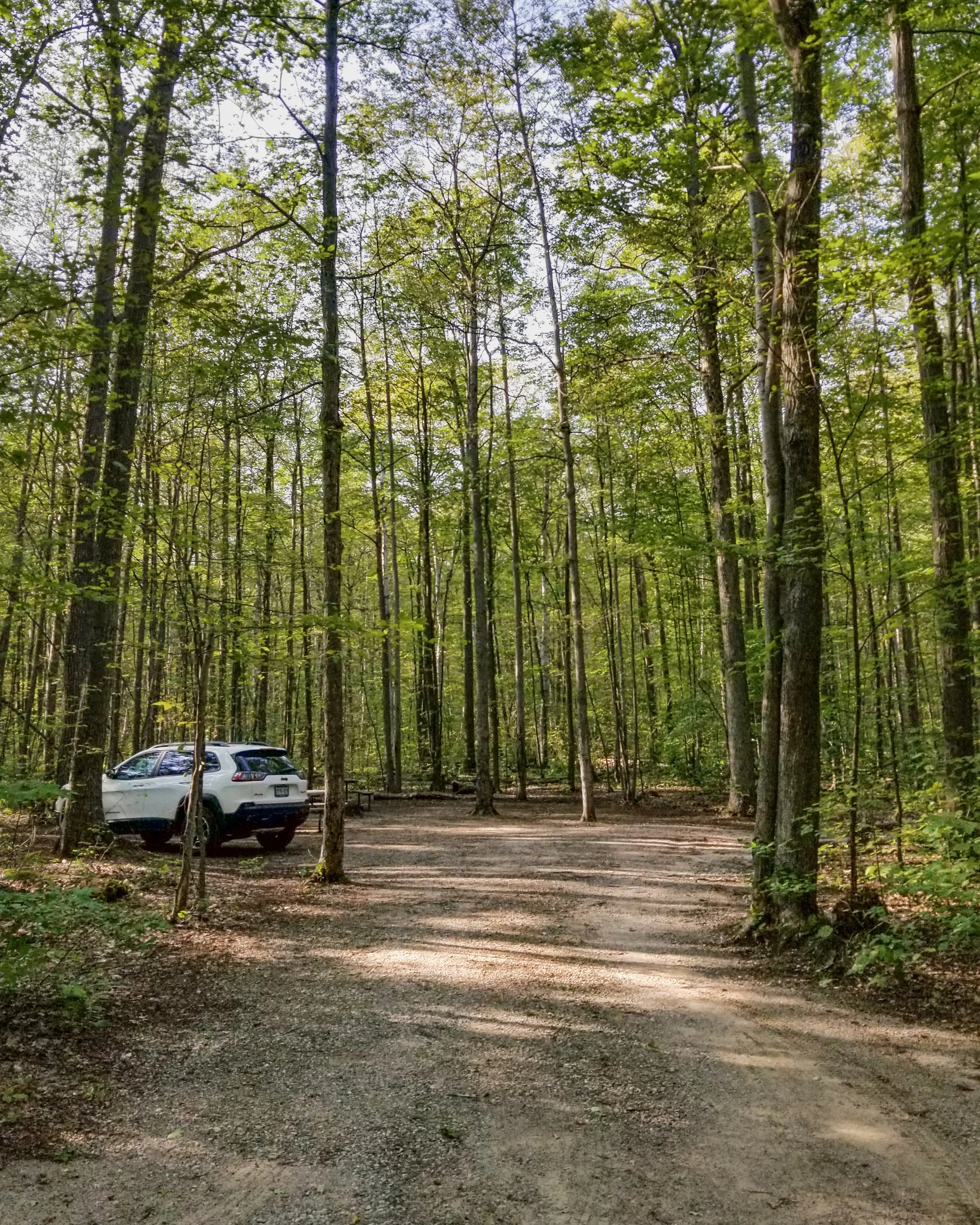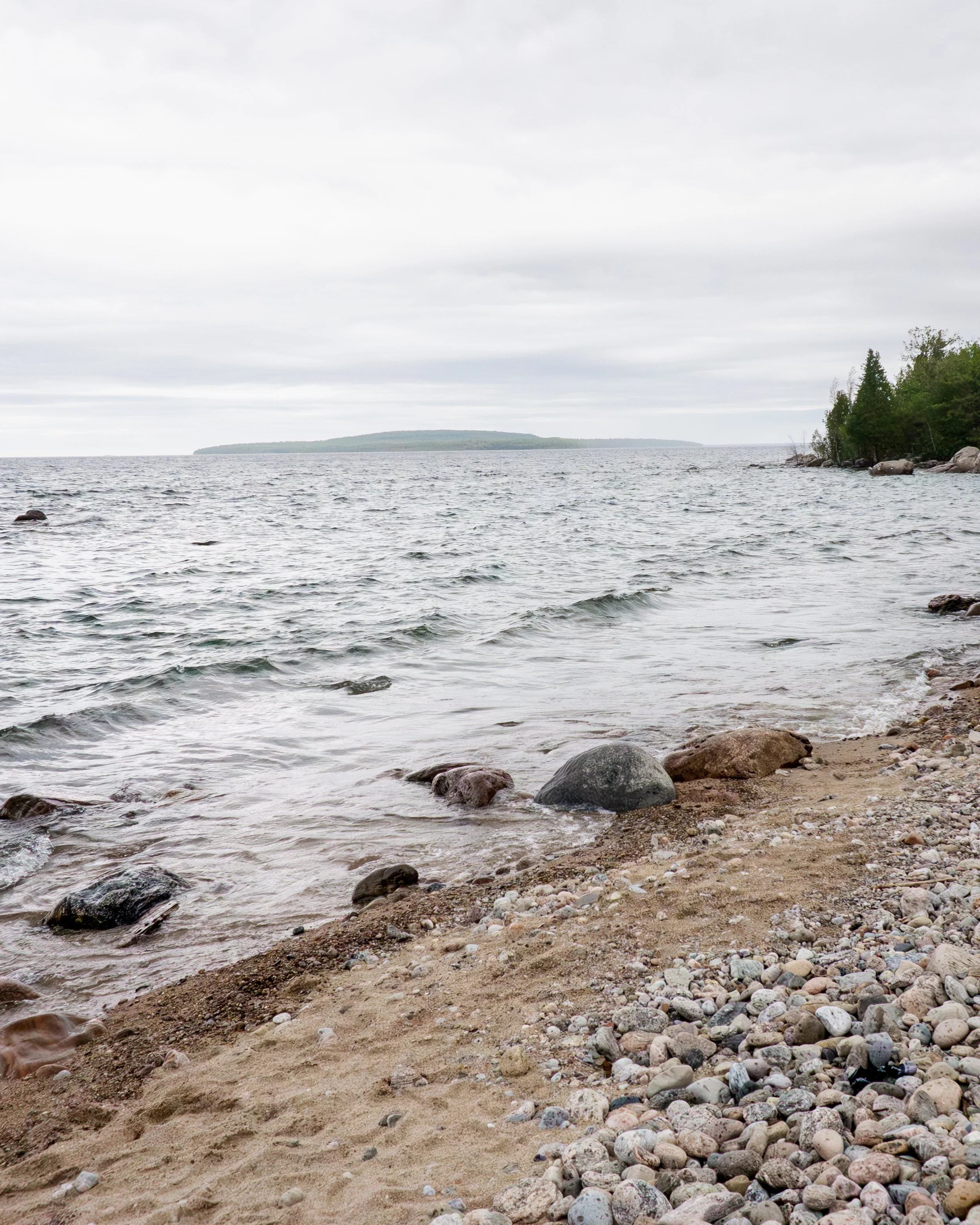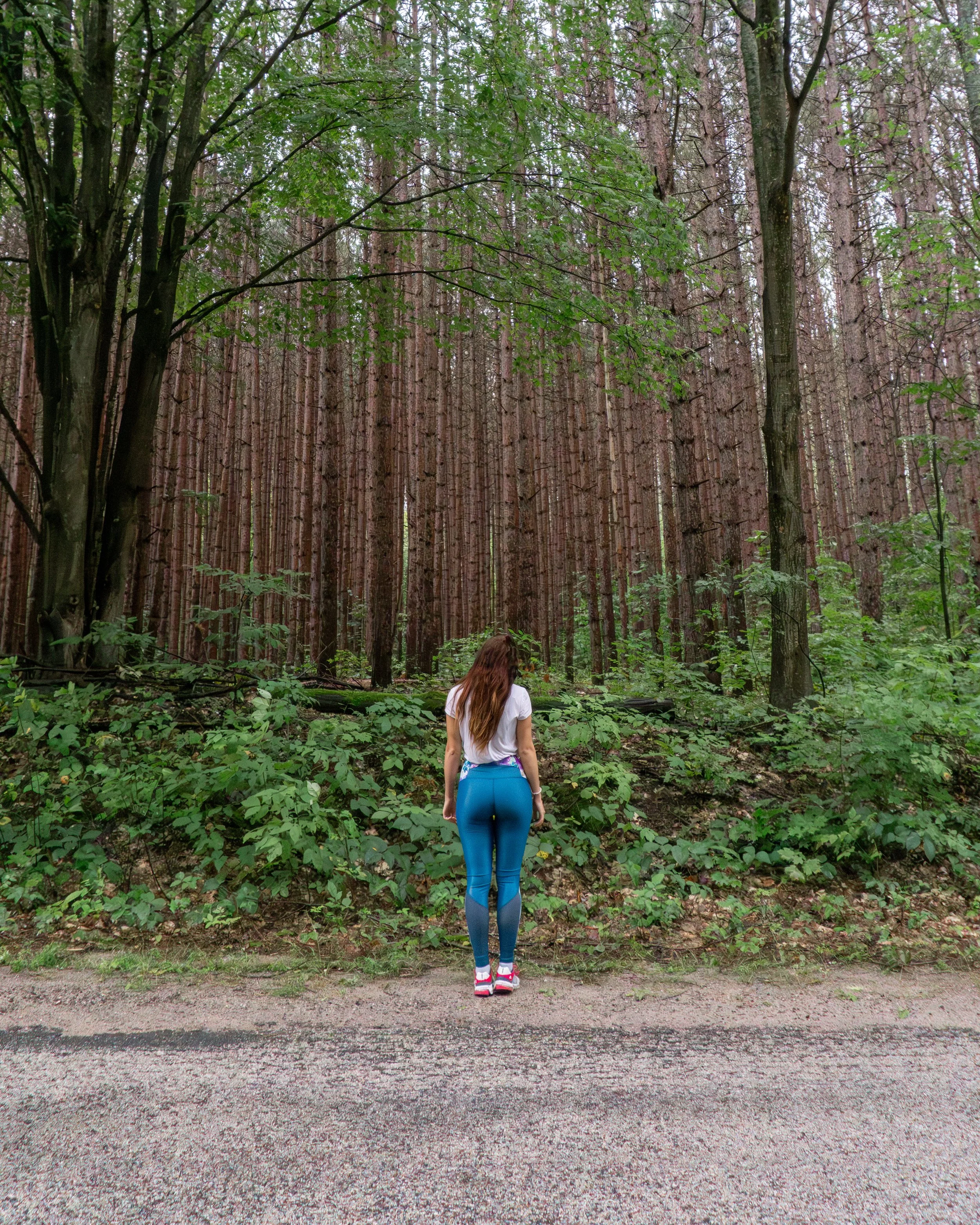Camping at Awenda Provincial Park
Did you know that a (somewhat) hidden oasis of lush forests, picturesque lakes, and adventurous trails lies just outside of Toronto?
Awenda Provincial Park is an interesting experience because it is very close to Toronto (about an 1 h 40), and yet, once you enter the densely forested area you feel as though you are miles away from the city. The park is located on Georgian Bay, at the top of the peninsula in Tiny. Tiny is a township in Simcoe County, beside better known Wasaga Beach. Awenda Provincial Park is also close to the town of Penetanguishene, on the southeasterly tip of Georgian Bay (about an 11 minute drive). We actually decided to head there before arriving at our campsite, and the drive there from Awenda was pleasing, as it exuded quintessential “country road bliss.” The town itself has a lovely charm - especially the main road, which consists of shops and restaurants, and descends to the lake.
I have spent many years in Tiny Township, exploring the beaches and rolling hills, yet was nicely surprised by this park’s lush atmosphere that I did not know existed here! I would absolutely consider it a hidden gem in the region.
Awenda is also full of history and legends (such as the Huron legend of Kitchikewana). Archeologists can date human habitation here back to 11,000 years ago, and there were many archeological sites found. They’ve excavated sites dating all the way back to pre-historic times and also 19th/20th century homesteads (cabins, farm buildings, fences, and more). Awenda was established as a provincial park in 1975. See the link at the end to read more about the history!
It is important to note that according to Johnny Hawke (Indigenous Activist from Beausoleil First Nation), the land here (including all beaches of Tiny Township) is a part of 50,000 acres that were unlawfully taken and misappropriated by the Crown in the 1795 Penetanguishene Purchase and the 1816 Lakes Huron and Simcoe Purchase. Hawke holds occasional educational rallies on this. The best way to respect and visit this area is to become educated on this matter, to support the Indigenous communities is belongs to, and to assist the communities in their efforts.
Campsites
Things To Do
Things To Note
Eco Camping Tips
Campsites
There are 6 campgrounds at Awenda, and they are all car-camping (there are no walk-in or backcountry campsites here): Wolf, Hawk, Deer, Bear, Snake, and Turtle (all named after clans of the Wendat). They are all beautifully situated beneath Maple and Oak forests. All of the campgrounds contain water taps, vault toilets, and a central comfort station (with flush toilets and showers). The comfort stations in Turtle, Hawk, and Bear also have laundry facilities.
All of the sites in Wolf and some sites in Hawk offer electrical hook-ups.
Deer and Bear are radio-free.
Snake is radio-free and dog-free.
And for those who are not interested in camping, there is one cottage at the park, which sleeps 6 people. There is a 6-night minimum from late June to Labour Day, and a 2-3 minimum stay outside of that. They also do not allow pets at the cottage.
We visited the park after the summer madness, as we decided to fit in one more camping trip before Fall Equinox hit us with the cooler weather. It was definitely the chilliest trips out of all (bonus: there were no mosquitoes). That, and it was a wild night - which I will explain in a minute. Our check-in was quick and easy and the staff was very friendly. We picked up our firewood at the check-in office.
To be honest, due to Awenda’s proximity to the beach towns I know very well, I was almost expecting a very commercialized experience, with a lot of the park cleared out for campsites. Wow, was I pleasantly surprised. Driving into the park, there were long sections of untouched forest. This seemed to be prominent within most of the park, which was quite beautiful to see. Compared to all of the other Ontario parks we visited, these campsites seemed to be the most spaced out - and they were quite large!
Our campground was at the end of a loop, beside a small field and a comfort station. Despite all of this, it felt very private. The campsite itself was incredibly sheltered by an oasis of trees; it felt as though we were somewhere in the woods up north. We were lucky because the water tap was at the front of our campsite too.
The comfort station beside us was actually completely closed for maintenance, which included the washrooms (with flushable toilets). We ended up creating a nice backcountry experience for ourselves and using the bushes, and then the next morning we realized the outhouses were only a two minute walk along a path beside us (oops, ha!).
The night itself was insane. We knew the weather was calling for some rain, so we had set one tarp under the tent and one over top (luckily, we had a wonderful cluster of trees above). All I can say is we were not prepared for what was to come. About an hour into our sleep, we got hit with pounding rain and distant thunder. It woke us up but we were able to fall back asleep. Shortly after, the rain intensified, the lightning was blinding (and close) and the thunder was roaring louder than ever. Once we somehow found peace throughout all of this chaos (we were so exhausted at this point), a thunder strike that was out for vengeance cracked so intensely that it shook the entire ground. For the first time, I felt completely terrified and unsafe. Foolishly, we stayed and waited it out and it eventually passed us. Most terrifying camping experience ever.
Luckily, although we thought our tarp set up would not suffice through this madness, our tent stayed dry (except for a small corner)! I do not recommend staying outside during a lightning storm; if the storm is in proximity, the lightning can hit the ground and the current can travel under the ground. The best option is to take shelter inside your car.
We stayed at the Snake Campground - lot 312 (Sept 6th - 7th)
Things to Do:
Awenda is a park that holds an incredible diversity of flora and fauna. It is an area full of beaches, sand dunes, old growth forests, wetlands, and bogs. It is classified as a Nature Reserve Zone and a provincial Area of Natural and Scientific Interest. What is interesting here is that it is located between Carolinian Canada (which is the most diverse and fragile ecoregion of Canada) and the Canadian Shield. There are two sections of the park; one is drier and sandy (in the upland) and the other is cool and wet (in the lowland).
There is definitely something for everyone at this park.
Biking. There are several kilometers of biking trails (mainly flat) and biking is allowed on 3 of the hiking trails (Beach, Bluff and Brule).
Bird Watching. Bird lovers will rejoice as there are over 120 bird species here, and ample spots to observe them!
Boating on Georgian Bay. The closest boat launch is in Penetanguishene.
Canoeing. For those who want to enjoy a quieter boat experience, they can head to Kettle’s Lake in the park. Kettle’s Lake is motor-free and perfect for canoeing! You can bring your own or rent a canoe from the park.
Fishing. There are several fish types found in the waters between Awenda and Giant’s Tomb Island, including: Bass, Northern Pike, Pickerel, and smaller Panfish. Bass and Panfish are also found in Kettle’s Lake.
Swimming and Sunbathing. There are several beaches here, all lining Georgian Bay - which are within driving distance of the campsites. There are no lifeguards at these beaches but the park has personal floatation devices that can be borrowed! There is 1 pet beach and the sandiest (and most protected) beach is Methodist Point Bay.
Hiking. Awenda has a large variety of hiking trails, with 31km of trails inside the park! You can also paddle out to Giant Tomb’s Island, which is owned by the park.
The hiking trails range from easy to moderate, from 1-13 km:
Beach Trail (4 km linear trail - easy hike along Georgian Bay shoreline, with views of Giant’s Tomb Island).
Beaver Pond Trail (1 km loop trail - easy & barrier-free hike on a boardwalk in a nature reserve (influenced by beaver activity), passing old remains of a building and bridge, views of Nipissing bluff, and many wildflower and bird species).
Bluff Trail (13 km loop trail - moderate hike partly along a high bluff and partly through a low wetland, passing scenic views of Georgian Bay).
Nipissing Trail (1 km linear trail - moderate steep staircase (155 steps) hike descending 32 metres to the face of Nipissing Bluff (the dominant glacial feature & raised beach created 5500 years ago by glacial Lake Nipissing).
Brûlé Trail (4 km linear trail - easy hike passing through deciduous forest).
Robitaille Homestead Trail (3 km linear trail - easy hike passing an abandoned farmstead and leading to an ancient dune system (with sand dunes from the time of the last glacial retreat over 11,500 years ago) - it is a very fragile environment).
Wendat Trail (5 km loop - easy hike beginning at Kettle’s Lake and passing foundations of Brabant farmstead and barn - keep an eye out for Red-winged Blackbirds and Great Blue Herons seen in the swamps around the lake).
This is another great park to visit in the winter months, as there are 17 km of snowshoeing and cross-country skiing trails. The ski trails do have a track but you can also create your own for a more backcountry experience. Good to note, they do not rent out this equipment so you must bring your own, and they do not allow dogs on these winter trails.
We were only at the park for one night and the rain continued on the next morning, so we did not get to explore the hiking trails sadly. We decided to head over to one of the beach areas after we packed up. The drive was wonderful. We drove through windy forested roads that lead to a very organized one-way entrance, with a road that loops all the way around the beach. This loop contained different parking lot areas. We found a spot at the very first lot, since it was gloomy and drizzling, and there were barely any people there. We didn’t let the weather stop us from admiring all of the beautiful rocks and driftwood by the water. The beach itself was quite lovely, as it was surrounded by forest, and provided lovely views in the distance.
On our way out of the park, we passed by the most incredibly vibrant red pine trees. We just had to stop and take some photos. As a note, there was quite a lot of poison ivy by the side of the road. Every car that passed by slowed down to see what we were admiring, probably thinking there was wildlife. But here we were, just admiring the beauty of nature. Definitely hoping to come back to explore the trails and enjoy the beaches! The park also used to be rich in white pines, but the lumber industry and forest fires completely obliterated all of them.
Things to Note:
Georgian Bay winds can be unpredictable; be cautious when you are on or near the water. The weather here is said to change and decline very quickly, so it is important to stay alert. We enjoyed a calm and cloudy evening for a few hours, and suddenly a tumultuous thunderstorm rolled in.
Be mindful of poison ivy at the park, as it is widespread here. Also, keep an eye out for the poisonous hemlock plants that seem to be appearing aggressively across Ontario.
The dunes on the Robitaille Homestead Trail are very sensitive. Make sure not to climb the hillside, stand on the edge of the bluff, or climb down the bluff.
Make sure to check out the vibrant red pines before you leave the park.
Take a day trip to Penetanguishene (or Penetang). It is a town full of history and one of the oldest towns in Ontario, that boasts one of the most beautiful and protected harbours. Here you can find restaurants and cafes, shops, museums, Discovery Harbour (replicas pertaining to the town’s past naval history), and cruises to the 30,000 islands of Georgian Bay. It is also the closest town with an LCBO and grocery store if you run out of anything.
Driving around the local area, you can find some great country markets. Make sure to keep an eye out! We found a stand selling sunflowers, dahlias, and other beautiful flowers!
Go on the hunt for a food truck called ‘The Goofy Newfie’ on an intersection in ‘Waverely’ (Tay Township) nearby. It won’t show up on Google Maps but they have a delicious authentic Newfie menu, including Newfie fries and poutine, fish and chips, and even cod tongues! It was a hidden gem find.
Eco Camping Tips:
Opt for biodegradable and natural soap & dish soap, toothpaste, sunscreen, bug repellent, and anything that may end up on the ground/in the water.
Try to buy organic food when possible, as to avoid pesticides and other chemicals that can be harmful for the environment. Also try to pack meals in larger containers (BPA-free), rather than purchasing single-use packaged items.
Remember to never leave food products outside, as animals can get to it.
Bring reusable sandwich bags, water bottles, cutlery, straws, etc. (if able). Also opt for reusable dishes and cups that you can quickly wash and wipe.
Bring a large water jug and fill it up at the water stations (if there are no stations, bring extra jugs of water).
Buy sleeping bags made of recycled materials.
Purchase camping stoves that can be refilled and reused.
Sort out your garbage and recycling. Ontario parks has bins for both.
Do not remove branches or bark from trees for fires. Use the dead brush on the ground and buy firewood from the park. Avoid bringing in outside firewood, as it can carry invasive and non-native species.
Never burn trash or anything that can contain chemicals, such as plastic or anything with toxic ink, paint, or glue on it.
Natural fire starters (instead of using lighter fluid): ethical soy/beeswax inside egg cartons, recycled woodchips, dried orange peels, cinnamon sticks/anise stars, pinecones & pine needles, shredded (plastic-free) paper/sawdust, and smudge sticks/sage.
Always use the fire pits, and not any other space.
Always pick up your trash and leave no trace! Make sure to scan the entire area before leaving.
Always have extra bags on hand for trash - whether that is your trash or trash you find along the way
A few bug spray alternatives that I love are: peppermint oil, lime oil (love this one), citronella (a staple), tea tree oil, lavender, and eucalyptus oil. For an all natural bug repellent, you can literally mix a few essential oils with some witch hazel or rose water (or simply, regular water).
I always recommend reading about the history of a location (making sure to read about and acknowledge the Indigenous groups it belongs to), information about delicate species and environments, and how to respect and protect the land and others. This park is especially rich in history and current affairs, so make sure to spend some time to learn about it prior to you trip!
Park Details: Ontario Parks
History and educational information: Friends of Awenda Park
I would like to acknowledge and express gratitude to the ancestral lands in the traditional territory of the Wendat (Huron) and the Beausoleil, Rama, and Georgina Island First Nations. I wish to recognize the long history of First Nations, Métis, and Inuit in Ontario, and show respect to them today, with the understanding that they will always belong to them.





